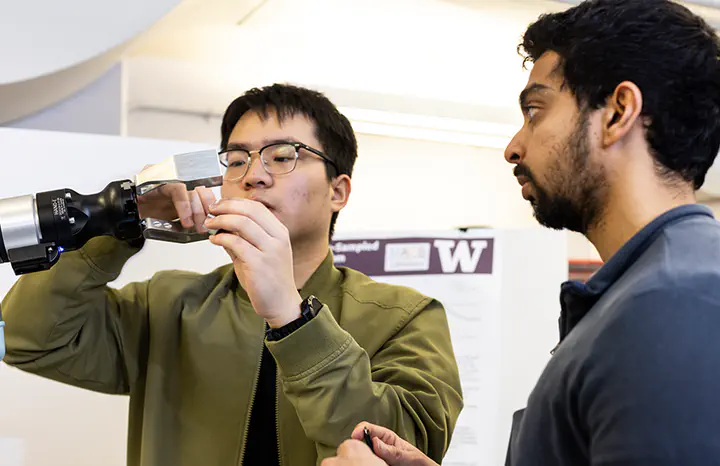MACS Lab Members Receive ASME Best Paper Awards

Congratulations to Ph.D. candidates Bob Xiaohai Hu and Thomas Chu for receiving 2024 Best Paper Awards from the ASME Dynamic Systems and Control Division for their recently published papers.


Detecting and preventing slip in robots
Hu was recognized for the paper “Learning to detect slip through tactile estimation of the contact force field and its entropy properties.” The research, funded by the UW + Amazon Science Hub, combines visual and tactile feedback in industrial robotics to detect and prevent object slipping during grasping. The team tested their approach with 10 common objects, including a sponge, box, tennis ball and screwdriver. Compared to previous studies, the team’s methods increased the accuracy of slip detection by about 10 percent.

“Our approach advances beyond conventional vision-based systems in two key ways,” Hu says. “First, we incorporate tactile feedback between the gripper and object. The secondary advancement involves quantitative analysis of random characteristics in the contact surface deformation field, which we characterize through vector field visualization of surface strain patterns.”
The tactile surface of the robotic grasper used for the research is similar to a gel surface. When the grasper makes contact with the object, the gel’s deformation in different areas can be visualized in real time with arrows. The randomness of these arrows indicate entropy — and the greater the entropy, the higher possibility of slippage.
“By developing mathematical models to quantify slippage severity, we implemented an adaptive feedback control algorithm that optimizes grasp stability during object acquisition and manipulation phases,” Hu says. “This integrated sensing-and-control architecture demonstrates improved performance metrics for autonomous manipulation tasks in industrial applications.”
Other MACS members who contributed to the paper include Prof. Chen; alums Aparajit Venkatesh and Navneet Kaur; and current ME graduate students Yusen Wan, Guiliang Zheng and Neel Jawale.
Removing unwanted vibrations in machines
Chu received the award for the paper “Optimal loop shaping and disturbance rejection beyond the Nyquist frequency using a forward model disturbance observer and convex optimization based filter design.” Chu’s research focuses on designing filters that remove vibrations, specifically vibrations that are too fast to be detected by the feedback sensor. In the case when the vibrations are fast to be detectable, a signal recovery method is used to estimate and rebuild the vibration for the feedback signal.
The filter can be applied to machines or devices that use a feedback control system, including hard disk drives. A feedback control system has sensors that measure information, such as movement or temperature, which it uses to provide feedback to correct itself. For example, a thermostat monitors the temperature and adjusts its heating or cooling based on the set temperature.

“An inherent limitation of a traditional feedback system is that the feedback system responds too slowly and is unable to remove the vibrations,” Chu says. “By adding an additional feedback loop, we are able to design the filter and isolate the vibrations in the feedback loop by ‘subtracting’ the vibration in the control signal. This is similar to how noise cancelling headphones work.”
The paper provides the filter design framework with a guaranteed performance. The researchers verified the filter design on a model of the lab’s galvo scanner machine, which controls the laser position used in selective laser sintering.